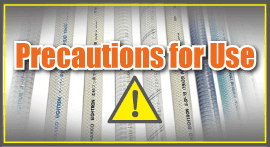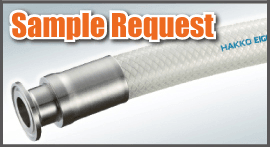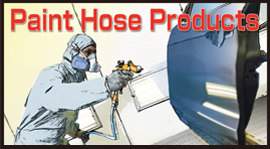General Questions about Hose/Tube/Fittings
Question 23: What is the difference between "Anti-Static" and "Conductivity"?
May 10,2025 General Questions about Hose/Tube/Fittings
Answer 23: "Anti-Static" [10<sup>9</sup> to 10<sup>13</sup>] means the ability to prevent the static electricity from accumulating. On the other hand, "Conductivity" [10<sup>3</sup> to 10<sup>5</sup>] means the ability of an object to conduct the electricity. Compared to anti-static properties, "Conductivity" allows the static electricity to be dissipated instantly due to its low resistance. Simply put, "Conductivity" ...
Question 22: Can SUS fittings be used for food and beverage applications?
May 10,2025 General Questions about Hose/Tube/Fittings
Answer 22: Yes. The Japanese Food Sanitation Law specifies the regulations for copper, lead, and their alloys in utensils, with lead content limited to 0.1% or less in tin used for plating, manufacturing, or repairing metal, and 5% or less in antimony. Since SUS is a material, specified in the JIS standards as containing neither ...
Question 21: Our equipment is originally from the United States and the UK. Could you please inform the screw thread standards?
March 15,2025 General Questions about Hose/Tube/Fittings
Answer: The thread made in Japan is based on ISO Standard. ISO Standard is compatible with BS Standard (UK Standard). However, NPT Standard (US Standard) is NOT compatible with ISO/BS Standards.
Question 20: How do we select a suitable product when two or more chemicals are mixed?
August 25,2024 General Questions about Hose/Tube/Fittings
Answer 20: If two or more chemicals are mixed, the chemical resistance chart is not reliable. (We are not sure about how two or more chemicals affect the material A.) Thus, we strongly recommend you to obtain the sample and test it in the application. Please request a sample here.
Question 19: Do you have the information on the recommended outer diameter size of fittings for hose inner diameter size of I.D. 12mm (for instance)?
June 25,2022 General Questions about Hose/Tube/Fittings
Answer 19: First of all, we always recommend you to use our original fittings, as the matching between our hose and fittings is guaranteed. However, in case you have no choice but to use the fittings produced by other manufacturers, our recommendation is that a fitting outer diameter size should be about 5-15 % bigger ...
Question 1: What is the lifetime of hose/tube?
June 02,2018 General Questions about Hose/Tube/Fittings
Answer 1: We are afraid that we cannot set the general lifetime, since the lifetime of the hose heavily depends on using conditions and using environments. If you find the following features, we strongly recommend that it is time to replace into a new hose. ...Tear, Scratches, swelling, crack, curve, deformation, and exposure of reinforced ...
Question 2: What happens to the working pressure at a higher temperature?
June 02,2018 General Questions about Hose/Tube/Fittings
Answer 2: As temperature goes up, hose/tube gets soften, leading to lower working pressure. Each product has technical data regarding "Relationship between Working Temperature and Maximum Working Pressure." Please check this data for each product.
Question 3: How do we cut hose/tube?
June 02,2018 General Questions about Hose/Tube/Fittings
Answer 3: You can cut a tube with a tube-cutter. For a hose, you can cut with a knife or a hose cutter. To cut a spring hose, make sure to cut the spring wire off neatly with a nipper.
Question 4: In what ways do we dispose of hose/tube?
June 02,2018 General Questions about Hose/Tube/Fittings
Answer 4: In case of disposing, please follow the local governmental regulations.
Question 5: What is the difference between burst pressure and working pressure?
June 02,2018 General Questions about Hose/Tube/Fittings
Answer 5: Burst pressure is the value of pressure when hose gets burst after adding pressure to the hose. Usually, a yarn-casting off or pinhole bursting occurs when hoses get burst. Burst pressure is usually as four times as working pressure. Also, depending on the temperature, working and burst pressure might change.










